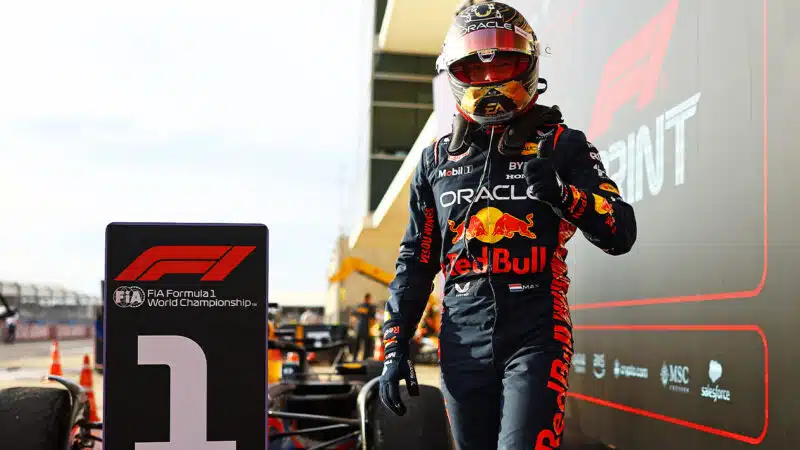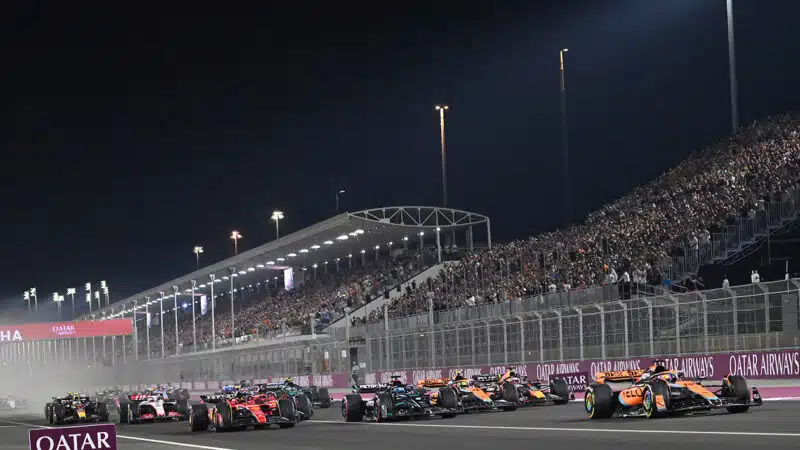2024 F1 sprint races: schedule, points and results
F1 sprint races are back in 2024 with a new calendar and a refreshed format. Here's how sprint race weekends will work, including the points awarded, race length the other potential changes in store

Max Verstappen won the last sprint in Austin
F1’s sprint race schedule has undergone a re-shuffle for 2024; the pocket-sized grand prix now hosted at six venues with a brand new format.
Friday will now host both FP1 and sprint qualifying, while Saturday will host the sprint itself as well as another qualifying session for Sunday’s full-length grand prix.
Each driver will also have access to four power units across the season instead of the traditional three — possibly resulting in fewer grid place penalties — and DRS can now be activated after one lap rather than two.
These changes come after considerable feedback from drivers, teams and fans, who wanted sprint events to be separated further from the race weekend, but the new schedule could have a major effect on parc fermé — which used to come into effect on Friday after FP1 ahead of grand prix qualifying.
With a sprint race now set between the first and second qualifying session of the weekend, some may argue that teams should be allowed to make grand prix specific changes to their car after Saturday’s sprint race has been completed which could then lead to better racing during Sunday’s grand prix.
The Sporting Advisory Committee are still currently working through specific details but are yet to announce any further changes.
2024 F1 sprint race calendar — schedule, results and start times
F1 announced its sprint race calendar for the 2024 season in October last year, which includes six races and two new host venues.
Interlagos and the Red Bull Ring remain as headliners — both returning as the only two circuits to have hosted an F1 sprint race in every season since their inception in 2021. COTA and Losail return after positive reactions to their sprint race debuts in 2023, while Shanghai and Miami join the line-up for the first time in 2024.
According to F1, the updated calendar has been designed to feature circuits which provide the most overtaking opportunities and therefore provide more entertainment for the fans and more point-scoring chances for the drivers.
2024 F1 sprint race times (UK)
This table shows the start time for each sprint race which will take place
How F1 sprint races work:
• Two qualifying sessions Drivers compete in a pair of qualifying sessions: one after practice on Friday for Saturday’s sprint race, and one on Saturday for Sunday’s grand prix.
Saturday’s sprint race grid is determined by the ‘sprint shootout’:
– All 20 drivers have only 12min to set a time in sprint qualifying 1 (SQ1)
– The five slowest drivers drop out before a 10min SQ2.
– Only the fastest ten go through to an 8min SQ3.
The race then follows on Saturday morning.
Grand prix qualifying is unchanged:
– An 18min Q1 for all 20 drivers where the five slowest are eliminated.
– Followed by a 15min Q2 where another five drivers are dropped.
– Finally a 12min Q3 for the final ten drivers.
• Reduced practice Practice sessions on sprint weekends have been cut from two to one, further limiting the amount of time to find the right set-up and simulate the different stages of the event. There are three practice sessions on a standard, non-sprint grand prix weekend.
• Six sprint weekends — doubling the three held per year in 2021 and 2022
Scroll down for more details or click to jump to a particular section:
• 2024 sprint race rules – including sprint race laps, length, points, tyre allocation and penalties
• How 2023 sprint changes have affected F1 racing
• 2023 Sprint race calendar
• What is a sprint race?
2024 F1 sprint race rules
How long are F1 sprint races?
Sprint races run to 100km (62 miles). Lap count varies depending on the circuit. For the Sao Paulo GP, the sprint race is set for 24 laps, which is just over a third of the 71-lap grand prix distance. There is also a time limit: races must be completed within 60 minutes, so if safety cars and stoppages take the action beyond an hour, it will be ended early.
F1 sprint race points table
The top eight finishers in the sprint race are awarded points. The winner receives eight championship points, reducing by one point per place.
| Position | Points |
| 1 | 8 |
| 2 | 7 |
| 3 | 6 |
| 4 | 5 |
| 5 | 4 |
| 6 | 3 |
| 7 | 2 |
| 8 | 1 |
2024 F1 sprint race qualifying format
Sprint races now have a dedicated qualifying session, no longer have a role in setting the grid for the grand prix and are held on a Friday after FP1.
Otherwise known as the ‘sprint shootout’, this qualifying session uses reduced session lengths in order to encourage drivers to set their fastest lap times right out of the gate. Those who are slow to start, risk being knocked out and starting Saturday’s sprint race further down the grid.
Grand Prix qualifying retains the same format and is held on the Saturday after the sprint race has concluded.
Friday sprint shootout qualifying |
Saturday grand prix qualifying |
|||
| Session | Length | Drivers eliminated | Session | Length |
| SQ1 | 12min | 5 slowest | Q1 | 18min |
| SQ2 | 10min | 5 slowest | Q2 | 15min |
| SQ3 | 8min | n/a | Q3 | 10min |
Which F1 driver gets pole position on sprint race weekends?
The new sprint race weekend format falls more in line with a regular grand prix weekend, with full-length qualifying still taking place on a Saturday. The fastest driver in this session, just like in every other grand prix weekend, will be on pole position for Sunday’s race.
This effectively eliminates any pole-sitter confusion, after two years of awkwardness where qualifying only set the grid for the sprint race. Drivers then started the grand prix in their sprint finishing position.
Initially in 2021, pole position was officially awarded to the winner of the sprint race, which proved unpopular as it removed recognition of the all-or-nothing qualifying laps that showcase drivers’ bravery and commitment. That was changed in 2022, so that the fastest qualifier was recorded as pole-sitter. But if they didn’t win in the sprint, they wouldn’t start at the front of the grand prix.
When will penalties apply in sprint races?
Identical to other F1 race weekends, penalties incurred during FP1 or Saturday’s grand prix qualifying will applied to Sunday’s full-length grand prix.
However, penalties incurred during the ‘sprint shootout’ will be only be applied to the sprint race. But should a driver be handed a grid penalty during Saturday’s sprint race, that will then be applied to Sunday’s grand prix.
Power unit penalties will only apply to the grand prix.
Sprint race tyre allocation
Tyre restrictions are different during sprint weekends. Teams receive 12 sets, rather than the standard 13. When sprint shootout qualifying is dry, drivers must only use one set of tyres per stage: a fresh set of mediums in Q1; more unused mediums in Q2 and fresh soft tyres in Q3.
There is a free choice of tyres for both the sprint on Saturday and the grand prix on Sunday.
Parc fermé rules
After feedback from drivers, the new sprint weekend format comes with adapted parc ferme rules which will allow teams to change the set-up of their car for sprint race and grand prix events.
The weekend will now consist of two parc fermé deadlines: one will take effect ahead of sprint qualifying on Friday afternoon and will last throughout Saturday’s sprint. The other will then start ahead of Saturday afternoon’s grand prix qualifying session and last throughout Sunday’s grand prix.
How did 2023 sprint race changes affect F1 racing?
With relatively few points at stake in the sprint (the winner gets eight as opposed to 25 in the grand prix), and no impact on their starting place in the next day’s grand prix — unlike last year — the idea was that drivers would be encouraged to follow their natural instincts and fight more aggressively, knowing that a mistake will prove less costly and won’t affect the next day’s grand prix.
However the verdict is still out. The first sprint under the new rules was in Baku, which provided little excitement and a predictable result with victory for an in-form Sergio Perez. The same couldn’t be said for both Austrian and Belgian sprint races, but both benefitted from changeable weather conditions, while the trio of safety car periods in Qatar ensured that no-one could pull away too far. COTA and Sao Paulo provided a glimpse at what sprint race events can provide, but ultimately still delivered the same result.
But there is hope for the new format, which — alongside an additional power unit supply — should give teams the opportunity to run at full pace during sprint sessions without it impacting on the grand prix itself, where the big point scoring opportunities are available.

Will sprints be a success in 2024?
Grand Prix Photo
